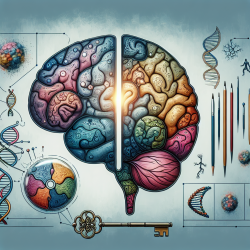The field of neurodevelopmental disorders (NDDs) is continuously evolving as new genetic insights come to light. One such advancement is the recent discovery of the role of biallelic variants in the CSMD1 gene, which has been implicated in a previously undefined NDD characterized by intellectual disability and variable cortical malformations. This breakthrough offers promising avenues for practitioners looking to enhance their therapeutic strategies and for researchers aiming to delve deeper into the genetic underpinnings of brain development.
The Significance of CSMD1
CSMD1 (Cub and Sushi Multiple Domains 1) is a gene known for its regulatory role in the complement cascade, a critical component of the innate immune response. High expression levels of CSMD1 are found in the central nervous system (CNS), where it plays a pivotal role in neural development and synaptic activity. While previously associated with neuropsychiatric disorders, its precise function in NDDs was unclear until now.
The study identified biallelic variants in CSMD1 among individuals from diverse ancestries who exhibited global developmental delay, intellectual disability, microcephaly, and polymicrogyria. By modeling CSMD1 loss-of-function pathogenesis using forebrain organoids derived from human embryonic stem cells, researchers demonstrated that CSMD1 is essential for maintaining neuroepithelial cytoarchitecture and synchronous differentiation.
Implications for Practitioners
For practitioners working with individuals affected by NDDs, these findings open up new possibilities for targeted interventions. Understanding the genetic basis of these disorders allows for more personalized therapeutic approaches. Here are some practical steps practitioners can take:
- Genetic Testing: Encourage genetic testing for patients with unexplained developmental delays or intellectual disabilities to identify potential CSMD1 variants.
- Early Intervention: Implement early intervention strategies that consider the specific genetic makeup of each individual, potentially improving outcomes.
- Collaborative Care: Work closely with genetic counselors and researchers to stay updated on the latest findings and integrate them into clinical practice.
Encouraging Further Research
The identification of CSMD1's role in NDDs is just the beginning. Researchers are encouraged to further explore the mechanisms by which CSMD1 influences brain development and its interaction with other genetic factors. This could lead to novel therapeutic targets and improve our understanding of how genetic variations contribute to neurodevelopmental disorders.
Moreover, studying the complement pathway's involvement in brain development offers insights into potential interventions that could mitigate or even prevent some of the adverse effects associated with these genetic mutations.
A Call to Action
This research underscores the importance of continued investigation into the genetic basis of neurodevelopmental disorders. By embracing these findings, practitioners can enhance their ability to provide effective care, while researchers can pave the way for groundbreaking discoveries that will benefit countless individuals worldwide.
To read the original research paper, please follow this link: Biallelic variants in CSMD1 are implicated in a neurodevelopmental disorder with intellectual disability and variable cortical malformations.










